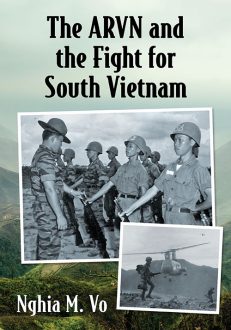The ARVN and the Fight for South Vietnam
$39.95
In stock
About the Book
With the withdrawal of French forces from South Vietnam in 1955, the U.S. took an ever-widening role in defending the country against invasion by North Vietnam. By 1965, the U.S. had “Americanized” the war, relegating the Army of the Republic of Vietnam (ARVN) to a supporting role. While the U.S. won many tactical victories, it had difficulty controlling the territory it fought for. As the war grew increasingly unpopular with the American public, the North Vietnamese launched two large-scale invasions in 1968 and 1972—both tactical defeats but strategic victories for the North that precipitated the U.S. policy of “Vietnamization,” the drawdown of American forces that left the ARVN to fight alone. This book examines the maturation of the ARVN, and the major battles it fought from 1963 to its demise in 1975. Despite its flaws, the ARVN was a well-organized and disciplined force with an independent spirit and contributed enormously to the war effort. Had the U.S. “Vietnamized” the war earlier, it might have been won in 1967–1968.
About the Author(s)
Bibliographic Details
Nghia M. Vo
Format: softcover (7 x 10)
Pages: 269
Bibliographic Info: 10 photos, glossary, appendix, notes, bibliography, index
Copyright Date: 2021
pISBN: 978-1-4766-8585-4
eISBN: 978-1-4766-4319-9
Imprint: McFarland
Table of Contents
Introduction: The Life and Death of the ARVN 1
1. From the National Army to the ARVN 9
2. 1963: The Ấp Bắc Battle 28
3. 1964: The Bình Giã Battle 36
4. 1965: Sông Bé, Ðồng Xoài, Bà Giã, Thuận Man, Plei Me 40
5. 1966: The South Vietnamese Economy 52
6. 1967: The Year of Decision 61
7. 1968: The Tết Offensive, Saigon, Huế, the Huế Massacre 68
8. 1969: Vietnamization, Hamburger Hill 93
9. 1970–71: Cambodian and Laotian Incursions 105
10. 1972: Quảng Trị–Kontum–An Lộc-Charlie 119
11. 1973: Nguyễn Vãn Thiệu’s Four Wars 148
12. 1974: The Paracel Islands, Thýợng Ðức, Phýớc Long 161
13. 1975: Ban Mê Thuột, the Fall of I Corps, Phan Rang, Xuân Lộc 175
14. Self Sacrifice, Reeducation Camps, Postwar Killings 189
15. Identity 216
Epilogue 227
Glossary 233
Appendix I—List of Vietnamese Reeducation Camps 235
Chapter Notes 237
Bibliography 255
Index 259
Book Reviews & Awards
• “The ARVN and the Fight for South Vietnam gives a South Vietnamese perspective of history, politics, religion, war, military successes and failures, reeducation camps, and much more….highly recommended” —VVA Veteran
• “The Army of the Republic of Vietnam (ARVN) fought bravely against the North Vietnamese invaders for more than a decade. Then the U.S. withdrew its support. The ARVN was defeated and destroyed. Vo Nghia tells their heartbreaking story with precision, detail, and enlightened understanding.”—Tom Glenn, Vietnamologist and author
• “Nghia Vo offers an honest appraisal of the role of the Army of the Republic of Vietnam during its conflict with North Vietnam and the Viet Cong. His focus on the South Vietnamese perspective reminds us that this war was complex and intense and did not end with the American withdrawal in 1973. In the continuous debate on the War in Vietnam, The ARVN and the Fight for South Vietnam provides agency for the South Vietnamese in their struggle for freedom.”—Ronald Frankum, Professor of History, Millersville University





